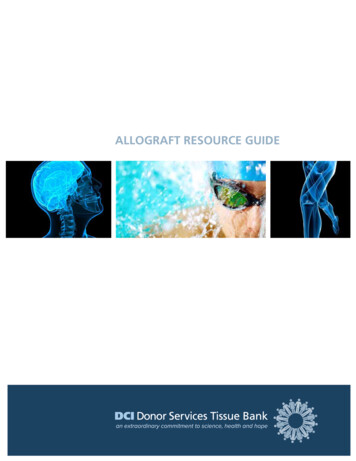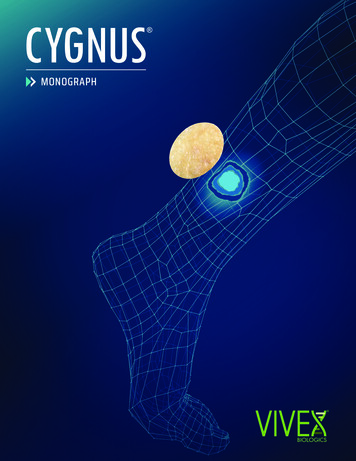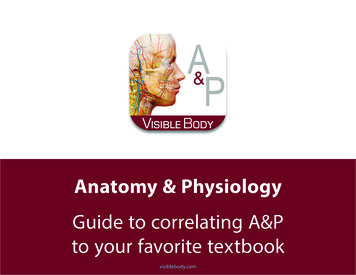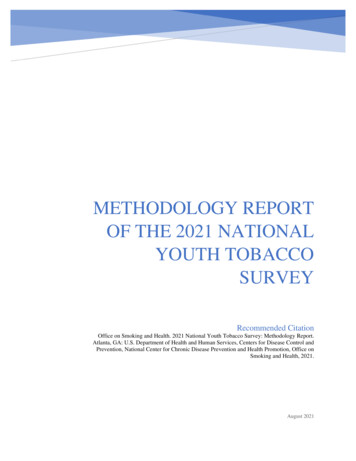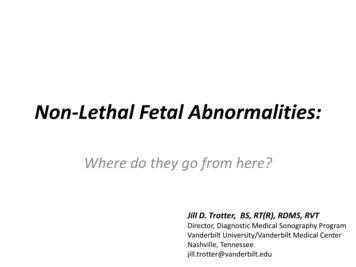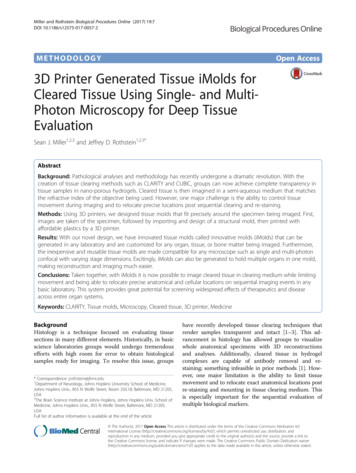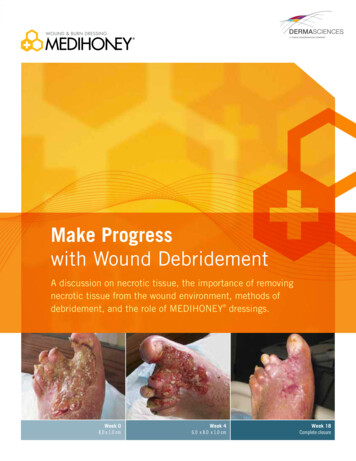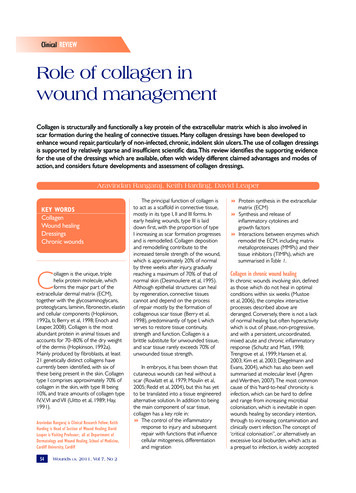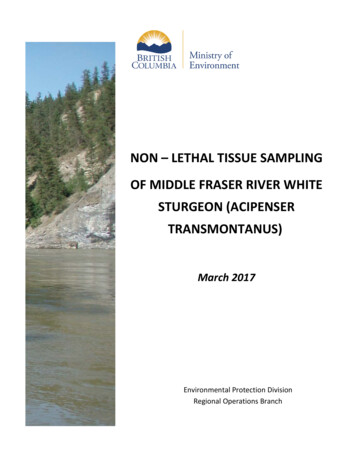
Transcription
NON – LETHAL TISSUE SAMPLINGOF MIDDLE FRASER RIVER WHITESTURGEON (ACIPENSERTRANSMONTANUS)March 2017Environmental Protection DivisionRegional Operations Branch
Non-Lethal Tissue Sampling of Middle Fraser River White Sturgeon (Acipenser transmontanus), Mar 2017AUTHORED BY: Kym Keogh, Environmental Impact Assessment Biologist1
Non-Lethal Tissue Sampling of Middle Fraser River White Sturgeon (Acipenser transmontanus), Mar 2017ACKNOWLEDGMENTSCost for sampling supplies and laboratory analysis for this project was provided by Gibraltar Mines Ltd. tofulfill their requirement under the Environmental Management Act Permit PE-416 to participate in a sturgeoncontaminant monitoring program. Thanks to Gabriele Matscha and Douglas Hill, Ministry of Environment forsupport in writing this report. Thanks to Chris Swan, Ministry of Environment and Mike Ramsay and LeeWilliston, Ministry of Forest, Lands and Natural Resource Operations for assistance with sample collection.Thanks also to the FLNRO Fisheries program for providing and operating the boat as well as the fishingequipment. Further thanks to Chris Swan for providing Photos 1 and 2 of the sampling technique. Thanks toCarl Schwartz, Simon Fraser University, for guidance and review of the statistical analyses. Thanks to DanBings and Jennifer McGuire, and Ann Godon of the Ministry of Environment for reviewing and providingcomment. Additional thanks to Gabriele Matscha for an extensive review throughout the writing of thisdocument.2
Non-Lethal Tissue Sampling of Middle Fraser River White Sturgeon (Acipenser transmontanus), Mar 2017EXECUTIVE SUMMARYNon-lethal tissue samples were collected from 31 Fraser River white sturgeon of varying sizes to determinebaseline metal levels prior to the discharge of mine effluent. Tissue samples were analyzed for six metals:cadmium, copper, mercury, molybdenum, selenium, and zinc. Of the 31 sturgeon sampled 6 were juvenilemortalities that were used to compare the results from the non-lethal tissue plug to the results from theaccepted standard of whole body analysis. The non-lethal tissue plugs showed no difference in copper andselenium results from that of the whole body results; however, mercury and zinc results exhibited adifference between the two sampling methods.Copper, mercury and zinc concentration generally increased with increased sturgeon size and by inference,increased sturgeon age. Selenium concentrations decreased as sturgeon length increased. There appears tobe a correlation between the decreasing selenium concentrations and the increasing mercury concentrationsin white sturgeon. Cadmium was not detectable in any of the muscle tissue. Molybdenum was rarelydetected and in the few cases, was close to the method detection limit.Baseline metal levels in middle Fraser River white sturgeon, when detectable, appear to be consistent withfindings in previous studies on Fraser River fish.3
Non-Lethal Tissue Sampling of Middle Fraser River White Sturgeon (Acipenser transmontanus), Mar 2017Introduction. 5Study Area . 6Figure 1. Middle Fraser River near Williams Lake, B.C. 6Methods . 7Figure 2. Tissue punches being collected . 7Figure 3. Extracting the plug . 8Figure 4. Tissue plug extraction site a year later . 8Figure 5. Plug removal on unfrozen juveniles . 9Results . 11Figure 6. Fish length versus copper concentration in muscle plugs . 11Figure 7. Fish length versus selenium concentrations in muscle plugs . 11Figure 8. Fish length versus mercury concentration in muscle plugs . 12Figure 9. Fish length versus zinc concentrations in muscle plugs . 12Figure 10. Age Growth Curves of White Sturgeon Stock Groups (SG) in the Fraser River Drainage (RL&L,2000) . 13Figure 11. Distribution of sampled sturgeon length . 13Figure 12. Comparison of mean mercury tissue concentrations across length categories . 14Figure 13. Comparison of mean selenium tissue concentrations across length categories . 14Figure 14. Comparison of mean copper tissue concentrations across length categories . 15Figure 15. Comparison of mean zinc tissue concentrations across length categories . 15Figure 16. Metal concentration differences between regular and replicate plugs . 16Discussion . 17Conclusions . 23References . 24Appendix A. Metal Concentrations in White Sturgeon Tissue Plugs . 27Appendix B. Metals Concentrations in Juvenile Muscle Tissues . 28Appendix C. Statistical Analyses Results . 294
Non-Lethal Tissue Sampling of Middle Fraser River White Sturgeon (Acipenser transmontanus), Mar 2017INTRODUCTIONKnowledge of middle Fraser River white sturgeon (Acipenser transmontanus) is limited and it is thought thatthis population remains localized within seasonally established areas to maximize the use of food resourcesin a harsh and limiting environment (RL&L, 2000). This sedentary approach to habitat use as well as itsbottom-feeding behaviour puts the white sturgeon at an increased risk from nearby effluent sources. Theapproval of an effluent discharge to the middle Fraser River from a copper-molybdenum mine north ofWilliam Lake, British Columbia (BC) required corroboration that white sturgeon were not taking up additionalmetal. To determine if metal accumulation in resident white sturgeon was occurring, an understanding ofpre-discharge metal levels in the fish was needed. A non-lethal tissue sampling program was initiated andoperated in conjunction with the Ministry of Forests, Lands, and Natural Resource Operations (FLNRO)Williams Lake Fisheries Section white sturgeon radio-tagging program.The tissue sampling project was developed to evaluate the effectiveness of non-lethal tissue sampling fordetermining metal concentrations and to obtain baseline tissue levels for the middle Fraser River whitesturgeon population. Due to the small population, slow growth, late sexual maturity, and long lifespan ofwhite sturgeon, the development of a non-lethal tissue sampling method was necessary. Tissue samplesfrom white sturgeon were analyzed for metals and fin samples were collected and analyzed for dioxins,furans and PCBs. The fin sampling and analyses data will be addressed separately. This document examinesthe baseline metal results and the effectiveness of the non-lethal study method.5
Non-Lethal Tissue Sampling of Middle Fraser River White Sturgeon (Acipenser transmontanus), Mar 2017STUDY AREASampling was conducted at different locations along the Fraser River section shown in Figure 1. The mineeffluent discharge diffuser is within the Fraser River adjacent to Tingley Creek outlet.Mine EffluentDischarge LocationFigure 1. Middle Fraser River near Williams Lake, B.C.6
Non-Lethal Tissue Sampling of Middle Fraser River White Sturgeon (Acipenser transmontanus), Mar 2017METHODSWhite sturgeon were caught on rod and reel with barbless baited hooks and brought to shore for non-lethalplug sampling. Sampling took place during September of 2007 and July, August, and September of 2008.Samples were collected from 31 white sturgeon.The non-lethal methodology developed for this project includes procedures, in part, from the federalguidelines for non-lethal fish tissue sampling for mercury (Env. Canada, 2012). Other guidance and researchprojects were also reviewed to establish the protocol (Rolfhus et al., 2008; US EPA, 2003). Nitrile gloves wereused for all sampling and handling of fish. Every tissue plug was created using a new sterile 12mm Acuderm tissue biopsy punch (Fig. 2).Figure 2. Tissue punches being collectedTissue plugs from each fish were removed from the body of the sturgeon using a newly-bladed stainless steelautopsy knife and stainless steel tweezers that had been washed with deionized water (Fig. 3). Both the knifeand tweezers were rinsed in laboratory-grade acetone just prior to use.7
Non-Lethal Tissue Sampling of Middle Fraser River White Sturgeon (Acipenser transmontanus), Mar 2017Figure 3. Extracting the plugTwo adjacent tissue plugs were combined to make up one tissue sample for each fish and together weighedapproximately 0.5 grams.Tissue plugs were placed in laboratory-grade glass bottles, labelled andimmediately stored on ice until they could be frozen at the MOE laboratory in Williams Lake, BC. Someveterinary-grade tissue adhesive 3MVetbond was applied to the plug location and allowed to dry forapproximately 30 seconds prior to the fish being released. Sampling was only done when the watertemperature was above 8 degrees Celsius to ensure successful healing as shown in Figure 4. All sampleswere kept frozen and shipped with ice to Brooks Applied Labs Ltd. in Seattle, Washington for metal analyses.Figure 4. Tissue plug extraction site a year later8
Non-Lethal Tissue Sampling of Middle Fraser River White Sturgeon (Acipenser transmontanus), Mar 2017Six elements were selected for analysis: cadmium (Cd), copper (Cu), mercury (Hg), molybdenum (Mo),selenium (Se) and zinc (Zn). Cadmium, copper, and molybdenum in the mine effluent were predicted toreach concentrations that would, at times, exceed BC water quality guidelines or the upstreamconcentrations in the Fraser River. Cadmium and copper at higher concentrations in the environment canadversely affect behavioural functions and the health of fish. Molybdenum was not known to affect fish butit was included due to its high concentrations in the mine effluent. Mercury, selenium, and zinc were notrelated to the mine effluent but are key elements associated with anthropological activities such as placermining, non-point source runoff, and agriculture.At high concentrations, all three can have extremelyadverse effects on fish health including the increased likelihood of mortality.As white sturgeon in the middle Fraser River are consider endangered (COSEWIC, 2012), a non-lethal methodwas needed to determine if metal concentrations in the sturgeon.As this non-lethal procedure had onlybeen established for mercury concentrations in fish, it needed to be validated against whole fish analysis toensure it was representative of the other metals as well. To facilitate the verification, 6 juvenile sturgeon,less than 1 meter in length, were caught, killed and frozen. A few months later, each fish was left to thaw inthe MOE laboratory for approximately 24 hours prior to sampling and dissection. The laboratory table wasstainless steel, washed and then rinsed with deionized water, and finally rinsed with laboratory-gradeacetone. Tissue plugs were removed following the same equipment and procedures used in the field (Fig. 5).Figure 5. Plug removal on unfrozen juvenilesReplicate plugs were also collected to quantify the variability within the muscle (Fig. 5). The plugs from thejuvenile sturgeon were refrozen and then shipped to Brooks Applied Labs Ltd. using the same process as theother samples. After the internal organs were removed, the sturgeon were filleted. Both muscle fillets,including skin, from each fish were considered one sample. The kidney, liver and fillet tissues were refrozen9
Non-Lethal Tissue Sampling of Middle Fraser River White Sturgeon (Acipenser transmontanus), Mar 2017and sent to Brooks Applied Labs Ltd for metal analyses. The results of the metal concentrations from theorgans are not discussed in this document.Fishing effort occurred at locations of known and probable habitat use within the middle Fraser River shown inFigure 1. White sturgeon had to be greater than 100 cm in length to minimize any effect from non-lethal samplingon fish health. White sturgeon caught and sampled were also evaluated by three length categories todetermine if the body burden metal concentrations varied across growth and life stages. The lengthdistributions were based on established middle Fraser River population growth stages such as sexual maturityat 20 years (140 cm) and a slowed growth rate after 200 cm (RL&L, 2000). All fish lengths were based on forklength of the fish and measured by FLNRO Fisheries staff. All fish caught and brought to shore were sampledif greater than 100 cm in length.Statistical analyses of tissue results for metals above detection limits were completed using SASjmp statistical software. The minimum baseline sample size was determined to be 25 through a power analysisthat could detect an effect with a 95% confidence interval for 25% around the mean. From the 6 metals Hgwas chosen for the power analysis as initial results had shown Hg concentrations were well above themethod detection limits. Replicate and regular plugs from the 6 juvenile sturgeon were averaged to provideone result in all analyses except the within-muscle comparison. Outliers were determined through acombination of reviewing field notes and scientific literature as well as completing various statistical analysessuch as residual analysis. Regression analyses were used to evaluate the relationship between metalconcentration and fish length. All statistical analyses used a significance level (alpha) of 0.05. The meanmetal concentrations were assessed against the length categories using one-way ANOVAs and the means ofthe length categories were also compared pair-wise using Tukey-Kramer HSD to determine statisticaldifferences. The different sampling methods, fillet versus plug, were compared to determine if the resultswere a factor of the method or differences between the fish. Matched pairs analysis using a paired t-test anda Tukey mean-difference plot was performed for Hg, Cu, Se and Zn concentrations to compare fillet to plugvalues and to compare replicate and regular tissue plugs within the same fish. The one-way ANOVA was usedto compare the mean concentrations of each metal from the 6 juvenile sturgeon for regular and replicateplugs as well as plugs and fillets.10
Non-Lethal Tissue Sampling of Middle Fraser River White Sturgeon (Acipenser transmontanus), Mar 2017RESULTSConcentrations of Cd, Cu, and Mo were predicted to be higher in the mine effluent discharge than the BCwater quality guidelines or the current levels in the Fraser River. The tissue analysis for baseline Cdconcentrations revealed that all results were below detection limits. For baseline Mo concentrations, 28results were below detection limit and 3 samples were above the detection limit but only 1 sample was high(0.289 µg/g wet weight) compared to the method detection limit of 0.006 µg/g. Copper was variable intissue samples and there was no statistical evidence (p 0.37) that Cu tissue concentrations increased withfish length despite the slightly increasing slope of the fit line (Fig. 6).Figure 6. Fish length versus copper concentration in muscle plugsIn addition to the three metals sampled for baseline information related to the mine effluent, Se, Hg and Znwere also analyzed.These elements often have increased levels in water and sediments due toanthropological activities and can have very adverse effects on fish health at high concentrations. All resultsfor these three metals were above the detection limit. Of the three metals, Se showed the strongestevidence (p 0.0002) of a relationship between concentration and fish length (Fig. 7).Figure 7. Fish length versus selenium concentrations in muscle plugs11
Non-Lethal Tissue Sampling of Middle Fraser River White Sturgeon (Acipenser transmontanus), Mar 2017The regression analysis of Hg concentrations had strong evidence of a relationship (p 0.0074) betweenincreasing fish length and increasing Hg concentrations (Fig. 8). There was no statistical evidence of arelationship for Zn (p 0.1330) and fish length. But like Cu, the fit line for Zn indicates an increasing trendbetween fish length and metal concentration (Fig. 9).Figure 8. Fish length versus mercury concentration in muscle plugsFigure 9. Fish length versus zinc concentrations in muscle plugs12
Non-Lethal Tissue Sampling of Middle Fraser River White Sturgeon (Acipenser transmontanus), Mar 2017Lengths categories were based on the white sturgeon study by RL&L, 2000, which determined growth stagessuch as sexual maturity at 20 years of age and approximately 140 cm for fish length, and slowing of growth,which happened after 200 cm as shown in Figure 10. Lengths of white sturgeon sampled had almost equalrepresentation across three length categories (Fig. 11). Fish caught and sampled included 10 fish shorterthan 140 cm in length, 11 fish between 140 and 200 cm in length, and 9 fish that were greater than 200 cm inlength.Figure 10. Age Growth Curves of White Sturgeon Stock Groups (SG) in the Fraser River Drainage (RL&L, 2000)Figure 11. Distribution of sampled sturgeon length13
Non-Lethal Tissue Sampling of Middle Fraser River White Sturgeon (Acipenser transmontanus), Mar 2017Mean Hg concentrations in Figure 12 showed a strong similarity across the two shortest categories but thelongest category (200 and over) did not overlap with either of the shorter fish lengths. The Tukey-Kramer allpairs analysis showed very strong evidence that the mean concentration of the shorter fish groups wasdifferent than the longest fish group (p 0.00136 and p 0.0036). Also of note is the greater variability in Hgconcentrations at the 200 cm fish lengths (Fig. 12).Figure 12. Comparison of mean mercury tissue concentrations across length categoriesGreen diamonds represent the mean, statistical overlap, and 95% confidence limit for each length group.Circles on the right illustrate strength of relationship where more overlap means more statistical evidence for similarity between the means.The Tukey-Kramer all pairs analysis of Se showed very strong evidence that the mean tissue concentration ofthe shortest category was statistically different (p 0.0031 and p 0.0023) than the means of the other lengthcategories. As seen in the graph (Fig. 13), Se concentrations in the shortest category are variable whencompared to the limited range of concentrations in the other two length categories.Figure 13. Comparison of mean selenium tissue concentrations across length categoriesA comparison of mean concentrations for Cu (Fig. 14) and Zn (Fig. 15) across length categories showed noevidence of a difference between the categories which is consistent with the results of regression analysesfor these metals.14
Non-Lethal Tissue Sampling of Middle Fraser River White Sturgeon (Acipenser transmontanus), Mar 2017Figure 14. Comparison of mean copper tissue concentrations across length categoriesFigure 15. Comparison of mean zinc tissue concentrations across length categoriesTo verify, whether the non-lethal plug sample was representative of the whole sturgeon, comparisons weremade between the concentrations found in the plugs and fillets of six juvenile white sturgeon.Copper concentrations in the plugs of the juveniles ranged from 0.45 to 0.82 µg/g wet weight (ww). Thefillets from the same six fish had a similar range of copper concentrations from 0.27 to 0.67 µg/g ww.Selenium concentrations in plugs (0.73 to 1.49 µg/g ww) had similar ranges to fillets (1.05 to 1.37 µg/g ww).Copper and selenium concentrations did not exhibit a statistical difference between the plug and filletmethod but the copper results were slightly less definitive (Cu Prop t 0.1101, Se Prop t 0.3186).Mercury concentrations in plugs ranged from 0.184 to 0.266 µg/g ww and in fillets from 0.180 to 0.374 µg/gww for the six juveniles. Zinc concentrations ranged from 7.27 to 10.8 µg/g ww in the juvenile sturgeon plugsand from 5.77 to 8.02 µg/g ww in the fillets of the same six sturgeon. Mercury and zinc analysis reportedsome evidence that plug sampling may not be representative of concentrations for the whole fish (Hg Prob t 0.0193, Zn Prob t 0.0159).Fillets generally had higher Hg concentrations and lower Znconcentrations than the plugs taken from the same fish.As the results for Cd and Mo for both the plugs and the fillets were below the method detection limits, noanalysis was completed.15
Non-Lethal Tissue Sampling of Middle Fraser River White Sturgeon (Acipenser transmontanus), Mar 2017Matched pairs analyses was also used to compare concentrations of metals in regular and replicate plugs tolook for variability within the muscle tissue but no evidence was found. The paired t-test results were Prob t 0.6609 for Hg, Prob t 0.3662 for Cu, Prob t 0.6648 for Se and Prob t 0.9737 for Zn. Lastly,the mean concentrations for each of the six metals from the regular plugs of the juvenile sturgeon werecompared to the mean concentrations of the replicate plugs and no differences were identified.Figure 16. Metal concentration differences between regular and replicate plugs16
Non-Lethal Tissue Sampling of Middle Fraser River White Sturgeon (Acipenser transmontanus), Mar 2017DISCUSSIONTissue sampling from middle Fraser River white sturgeon was dual purposed: to establish baseline metalvalues prior to the mine effluent discharge and to determine if non-lethal plug samples were representativeof the more standardized lethal muscle sampling. The following section discusses how baseline tissue metalresults compare to similar sampling of fish tissue in the Fraser River. Further, this section looks at other plugsampling and compares the information to that of this study.Baseline Metal ConcentrationsCadmiumCadmium is known to accumulate primarily in the kidneys and liver of aquatic organisms so muscle tissue willtypically have the lowest concentrations of the different body tissues (BC Min. of Env. 2015; Chowdhury,2005).All the Cd results from the tissue plugs were below method detection limits. An earlier study (MacDonald etal., 1997) on three Fraser River white sturgeon of varying lengths found Cd concentrations in muscle werealso below detection levels though these ranged from 0.05 to 0.44 µg/g wet weight (ww).A study on Cd accumulation in the muscle tissue of common carp (Malekpouri et.al, 2011) found that Cdcould accumulate to levels significantly different (P 0.05) than the control population. The study capturednine combinations of three Cd concentrations of 10 µg/L, 50 µg/L and 100 µg/L across three exposuretimeframes of 30, 60 and 90 days. The lowest muscle concentration of 0.03 µg/g dry weight (dw) occurred inthe lowest exposure (30 days) and the lowest concentration (10 µg/L) of waterborne Cd. The otherexperiments in this study resulted in more exposure and/or higher Cd concentrations with the maximumcombination (100 µg/L for 90 days) resulting in a mean Cd concentration of 12 µg/g dw in carp muscle tissue.The increased Cd in muscle did not appear to have any consistent effect on fish growth as either measured byfork length or fish weight (Malekpouri et al., 2011). The method detection limit for Cd analysis in middleFraser River white sturgeon ranged from 0.002 to 0.004 µg/g ww which is a magnitude lower than thecommon carp results and the method detection level used in the earlier McDonald et al. (1997) study butcadmium was still not detected.MolydenumMolybdenum is an essential element but like many metals is stored in the liver and kidneys (Regoli et.al,2012).Molybdenum results were below detection levels in all but 3 samples. Of the three samples, two had Moconcentrations near detection limits (0.004 to 0.01 µg/g ww) but one sample had a high Mo concentration(0.289 µg/L). A study examining accumulation of molybdenum in rainbow trout muscle tissue found thateven when the initial Mo concentration in the water was 11,000 µg/L, the muscle concentrations peaked atday 28 in the range of 0.7 µg/g, but by day 120, had dropped back to below the detection limit (Regoli et al.,2012). The study concluded that Mo does not accumulate in fish muscle tissue despite high levels occurring17
Non-Lethal Tissue Sampling of Middle Fraser River White Sturgeon (Acipenser transmontanus), Mar 2017in the aquatic environment. While it is not known if the three Mo concentrations above detection limitswere due to procedural contamination, it can be concluded that the one high concentration was an outlierand generally Mo concentrations were near or below detection limits.CopperCopper at sub-lethal levels can affect many functions in fish including reproduction, behaviour, growth, bloodchemistry, olfaction, and metabolism (Singleton, 1987). While copper can be found in muscle tissue ittypically accumulates in the liver.The baseline results for the middle Fraser River found that Cu concentrations were highly variable across allthe white sturgeon lengths and ranged from 0.27 to 1.44 µg/g ww. Tissue sampling of 3 white sturgeon inthe Prince George area in 1991 found an average copper concentration for muscle tissue of 0.29 0.07 ug/gww (MacDonald et al., 1997). A study on Fraser River fish caught near Marguerite in 1994 and 1995ascertained that average Cu concentrations in peamouth chub muscle were 0.62 (0.5 – 0.7) µg/g ww and 0.36(0.24 – 0.44) µg/g ww respectively (Raymond et al., 2001). The same study found the Cu concentration inmountain whitefish muscle were 1.26 (0.54 – 1.88) µg/g ww and 0.46 (0.43 – 0.50) µg/g ww. The studysuggested that mountain whitefish, as a bottom feeder, had higher Cu concentrations on average due to theiringestion of sediment (Raymond et al., 2001). The average plug concentration for the 31 Fraser Riversturgeon which includes the 6 juveniles was 0.91 0.34 µg/g ww which was similar to the averageconcentrations in mountain whitefish near Marguerite in 1994.In a study of uncontaminated lakes in BC, it was established that the mean Cu concentration in 112 rainbowtrout from 24 lakes was 0.39 0.29 µg/g ww (Rieberger, 1992). The 1992 study also collected 20 mountainwhitefish from 4 lakes which had an average Cu concentration of 0.35 0.20 µg/g ww. While this study isnot directly relevant to sturgeon living in a river, it does provide further comparison of baseline metalconcentrations in BC.In 2008, a US Fish and Wildlife Service study found that 6 hatchery shortnose sturgeon (3.5 to 5.5 years old)of similar weight and with an average fork length of 62.8 cm, had an average Cu concentration in the fillet of0.32 0.01 µg/g ww (Mierzykowski, S. 2012). In the same study a combined sample from two 2.5 year oldsturgeon which were half the weight of 3.5 to 5.5 year old fish identified above, had a Cu concentration of0.24 µg/g ww (Mierzykowski, S. 2012). The whole body of a single 1.5 year old sturgeon was analyzed whichresulted in a high Cu concentration of 1.40 µg/g (ww), probably due to the inclusion of organs which aretypically higher in Cu. The 6 fillets from the Fraser River juvenile white sturgeon, with fork lengths rangingfrom 67 cm to 86 cm, had an average Cu concentration of 0.42 0.14 µg/g ww. While slightly higher than thehatchery sturgeon in the US Fish and Wildlife Service study, the Fraser River sturgeon are assumed to beolder as reflected in their larger length.Copper concentrations in white sturgeon seem to be consistent with the concentrations found in other fishstudies in the Fraser River and in white sturgeon juveniles found in other areas.18
Non-Lethal Tissue Sampling of Middle Fraser River White Sturgeon (Acipenser transmontanus), Mar 2017ZincThe effects of zinc to fish mainly involve breathing such as gill damage, hypoxia, and impaired gas exchange(Eisler, 1993). As implied by the toxic effects, accumulation of zinc in fish is typically greatest in the gills andleast in the body muscle although the exact pattern of accumulation may vary by species (Rajkowska andProtasowicki, 2013).Zinc concentrations in the middle Fraser River white sturg
baseline metal levels prior the discharge of mine effluent. Tissue samples were analyzed for six metalsto : . Cadmium was not detectable in any of the muscle tissue. Molybdenum was rarely . 2003) .Nitrile gloves were used for all sampling and handling of fish. Every tissue plug was created using a new sterile 12mm . Acuderm .
